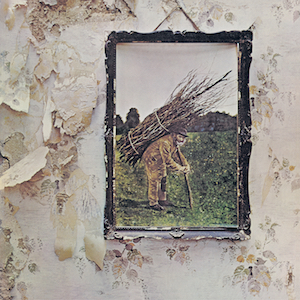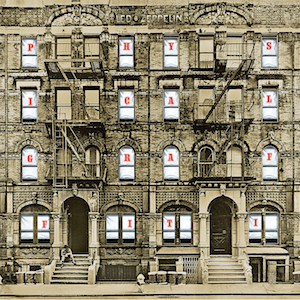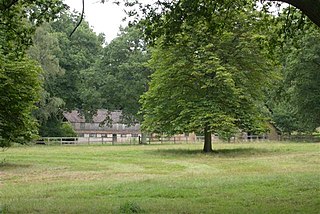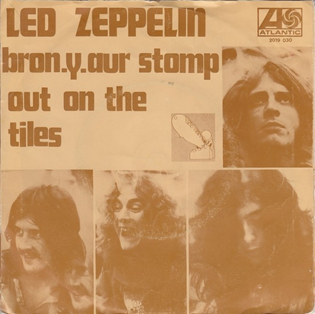
Led Zeppelin were an English rock band formed in London in 1968. The group comprised vocalist Robert Plant, guitarist Jimmy Page, bassist and keyboardist John Paul Jones, and drummer John Bonham. With a heavy, guitar-driven sound, they are cited as one of the progenitors of hard rock and heavy metal, although their style drew from a variety of influences, including blues and folk music. Led Zeppelin have been credited as significantly impacting the nature of the music industry, particularly in the development of album-oriented rock (AOR) and stadium rock.

Led Zeppelin III is the third studio album by the English rock band Led Zeppelin, released on 5 October 1970. It was recorded in three locations. Much of the work was done at Headley Grange, a country house, using the Rolling Stones Mobile Studio. Additional sessions were held at Island Studios and Olympic Studios in London. As with the prior album, the band eschewed the use of guest musicians, with all music performed by band members Robert Plant (vocals), Jimmy Page (guitars), John Paul Jones, and John Bonham (drums). The range of instruments played by the band was greatly enhanced on this album, with Jones especially emerging as a talented multi-instrumentalist, playing a wide range of keyboard and stringed instruments, including various synthesizers, mandolin and double bass, in addition to his usual bass guitar. As with prior albums, Page served as producer on the album, with mixing done by Andy Johns and Terry Manning.

The untitled fourth studio album by the English rock band Led Zeppelin, commonly known as Led Zeppelin IV, was released on 8 November 1971 by Atlantic Records. It was produced by guitarist Jimmy Page and recorded between December 1970 and February 1971, mostly in the country house Headley Grange. The album contains the band's most well-known recording, the eight-minute-long "Stairway to Heaven".

Physical Graffiti is the sixth studio album by the English rock band Led Zeppelin. Released as a double album on 24 February 1975 in the United States and on 28 February 1975 in the United Kingdom, it was the group's first album to be released under their new label, Swan Song Records. The band wrote and recorded eight new songs for the album in early 1974 at Headley Grange, a country house in Hampshire, which gave them ample time to improvise arrangements and experiment with recording. The total playing time covered just under three sides of an LP, so they decided to expand it into a double album by including previously unreleased tracks from the sessions for the band's earlier albums Led Zeppelin III (1970), Led Zeppelin IV (1971) and Houses of the Holy (1973). The album covered a range of styles including hard rock, progressive rock, rock 'n' roll and folk. The album was then mixed over summer 1974 and planned for an end-of-year release; however, its release was delayed because the Peter Corriston-designed die-cut album cover proved difficult to manufacture.

Lizzie Douglas, better known as Memphis Minnie, was a blues guitarist, vocalist, and songwriter whose recording career lasted for over three decades. She recorded around 200 songs, some of the best known being "When the Levee Breaks", "Me and My Chauffeur Blues", "Bumble Bee" and "Nothing in Rambling".

"Misty Mountain Hop" is a song by English rock band Led Zeppelin, released in 1971 by Atlantic Records. The song appears on the band's untitled fourth album, and was released as the B-side to the single "Black Dog" and performed in most of the band's 1972 and 1973 concert tours. In 2019, Rolling Stone ranked the song number 10 on its list of the 40 greatest Led Zeppelin songs.

"Black Dog" is a song by English rock band Led Zeppelin. It is the first track on the band's untitled fourth album (1971), which has become one of the best-selling albums of all time. The lyrics contain typical bluesman themes of lust, eroticism and betrayal. The song was released as a single and reached the charts in many countries. It is "one of the most instantly recognisable Zeppelin tracks", and was included in Rolling Stone's 500 Greatest Songs of All Time list (US), and ranked No. 1 in Q magazine's (UK) "20 Greatest Guitar Tracks".

Headley Grange is a former workhouse in Headley, Hampshire, England. It is a Grade II listed historic building. It is best known for its use as a recording and rehearsal venue in the 1960s and 1970s, by acts including Led Zeppelin, Genesis, Bad Company and Help Yourself.

Wilbur Joe "Kansas Joe" McCoy was an American Delta blues singer, musician and songwriter.
"Achilles Last Stand" is a song by the English rock group Led Zeppelin released as the opening track on their seventh studio album, Presence (1976). Guitarist Jimmy Page and singer Robert Plant began writing the song during the summer of 1975 and were influenced by Eastern music, mythology, and exposure to diverse cultures during their travels. At roughly ten-and-a-half minutes, it is one of the group's longest studio recordings and one of their most complex, with interwoven sections and multiple, overdubbed guitar parts.
"Since I've Been Loving You" is a song by the English rock band Led Zeppelin, released in 1970 on the album Led Zeppelin III.
"No Quarter" is a song by English rock band Led Zeppelin that appears on their 1973 album Houses of the Holy. It was written by John Paul Jones, Jimmy Page, and Robert Plant. The song became a centerpiece at all Led Zeppelin concerts thereafter, until their final tour. It appears in both the film versions and both live album versions of The Song Remains the Same, released in 1976 and expanded in 2007. It appeared once more in 1994 on Page and Plant's reunion album as the title track. It also appears on Led Zeppelin's 2012 live album Celebration Day, which documented their 2007 reunion performance at the O2 Arena in London. It was re-released on the deluxe edition of Houses of the Holy.
"White Summer" is a guitar instrumental by English rock guitarist Jimmy Page. It is an adaptation of the Irish air “She Moves Through The Fair." Page initially recorded and performed it with the Yardbirds and later included it in many Led Zeppelin concerts.
"Tangerine" is a folk rock song by the English band Led Zeppelin. Recorded in 1970, it is included on the second, more acoustic-oriented side of Led Zeppelin III (1970). The plaintive ballad reflects on lost love and features strummed acoustic guitar rhythm with pedal steel guitar.

"In My Time of Dying" is a gospel music song by Blind Willie Johnson. The title line, closing each stanza of the song, refers to a deathbed and was inspired by a passage in the Bible from Psalms 41:3 "The Lord will strengthen him upon the bed of languishing, thou wilt make all his bed in his sickness". Numerous artists have recorded variations, including Bob Dylan and Led Zeppelin.
"Celebration Day" is a song by English rock band Led Zeppelin, and the third track from their 1970 album Led Zeppelin III. The band's last concert film and album, released on 19 November 2012, took their name from this song.

"Bron-Y-Aur Stomp" is a song recorded by English rock band Led Zeppelin for their third album, Led Zeppelin III, released in 1970.

"It's Nobody's Fault but Mine" or "Nobody's Fault but Mine" is a song first recorded by gospel blues artist Blind Willie Johnson in 1927. It is a solo performance with Johnson singing and playing slide guitar. The song has been interpreted and recorded by numerous musicians in a variety of styles, including Led Zeppelin on their 1976 album Presence.

"Me and My Chauffeur Blues" is a song written and recorded by blues singer and guitarist Memphis Minnie in 1941. It was added to the U.S. National Recording Registry in 2019. A number of other musicians have recorded the song, or adaptations of it, often under shortened titles.












